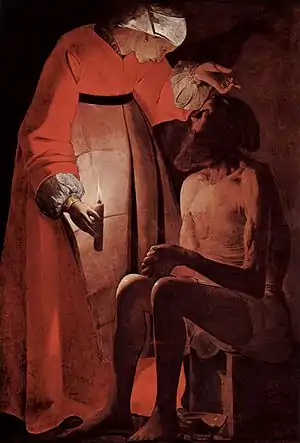List of names for the biblical nameless
This list provides names given in history and traditions for people who appear to be unnamed in the Bible.
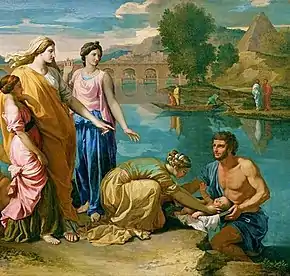
Hebrew Bible
Serpent of Genesis
Revelation 12 is thought to identify the serpent with Satan, unlike the pseudepigraphical-apocryphal Apocalypse of Moses (Vita Adae et Evae) where the Devil works with the serpent.[1]
Wives of the antediluvian patriarchs
The pseudepigraphical Book of Jubilees provides names for a host of otherwise unnamed biblical characters, including wives for most of the antediluvian patriarchs. The last of these is Noah's wife, to whom it gives the name of Emzara. Other Jewish traditional sources contain many different names for Noah's wife.
The Book of Jubilees says that Awan was Adam and Eve's first daughter. Their second daughter Azura married Seth. For many of the early wives in the series, Jubilees notes that the patriarchs married their sisters.
| Patriarch | Wife |
|---|---|
| Cain | |
| Seth | Azûrâ |
| Enos | Nôâm |
| Kenan | Mûalêlêth |
| Mahalalel | Dinah |
| Jared | Baraka |
| Enoch | Edna |
| Methuselah | Edna |
| Lamech (Seth's line) | Betenos |
| Noah |
The Cave of Treasures and the earlier Kitab al-Magall (part of Clementine literature) name entirely different women as the wives of the patriarchs, with considerable variations among the extant copies.
The Muslim historian Ibn Ishaq (c. 750), as cited in al-Tabari (c. 915), provides names for these wives which are generally similar to those in Jubilees, but he makes them Cainites rather than Sethites, despite clearly stating elsewhere that none of Noah's ancestors were descended from Cain.
Cain and Abel's sisters
- Name: Aclima (or Calmana or Luluwa)
- source: Golden Legend,[3] which also tells stories about many of the saints
Appears in the Bible at: Genesis 4:17
- Name: Delbora
- source: Golden Legend,[3] which also tells stories about many of the saints
Appears in the Bible at: Genesis 4
See also: Balbira and Kalmana, Azura and Awan for alternate traditions of names.
Noah's wife
- Name: Naamah
- Source: Midrash Genesis Rabbah 23:4
Appears in the Bible at: Genesis 4:22; Gen. 7:7
Daughter of Lamech and Zillah and sister of Tubal-cain (Gen. iv. 22). According to Abba ben Kahana, Naamah was Noah's wife and was called "Naamah" (pleasant) because her conduct was pleasing to God. But the majority of the rabbis reject this statement, declaring that Naamah was an idolatrous woman who sang "pleasant" songs to idols.
See also Wives aboard the Ark for a list of traditional names given to the wives of Noah and his sons Shem, Ham, and Japheth.
Ham's wife
- Name: Egyptus
- Source: Book of Abraham
Appears in the Bible in Genesis 7 and 6
The Mormon Book of Abraham, first published in 1842, mentions Egyptus (Abraham 1:23) as being the name of Ham's wife; his daughter apparently had the same name (v. 25).
Nimrod's wife
A large body of legend has attached itself to Nimrod, whose brief mention in Genesis merely makes him "a mighty hunter in the face of the Lord". (The biblical account makes no mention of a wife at all.) These legends usually make Nimrod to be a sinister figure, and they reach their peak in Hislop's The Two Babylons, which make Nimrod and his wife Semiramis to be the original authors of every false and pagan religion.
Mother of Abraham
- Name: Amatlai bat Karnevo
- Source: Babylonian Talmud, Bava Batra 91a [4]
Appears in the Bible at: Book of Genesis
Lot's married daughter
- Name: Paltith
- Source: Book of Jasher 19:24[5]
Appears in the Bible at: Book of Genesis
Lot's wife
- Name: Ado (or Edith, or Erith)
- Source: Book of Jasher 19:52 (Ado);[5] Pirkei De-Rabbi Eliezer (Edith)[6]
Appears in the Bible at: Book of Genesis
Potiphar's wife
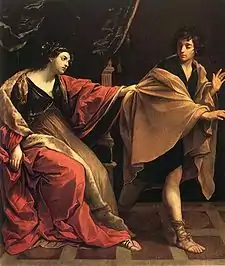
- Name: Zuleikha
- Source: The Sefer Hayyashar, a book of Jewish lore published in Venice in 1625. Also, the Persian mystical poem "Yusuf and Zulaikha" by Jami, 15th century.
Appears in the Bible at: Genesis 39:12
Pharaoh's daughter
- Name: Merris
- Source: Eusebius of Caesarea (Preparation for the Gospel 9.15)
- Name: Merrhoe
- Source: Eustathius of Antioch (Commentary on Hexameron MPG 18.785)
- Name: Thermutis
- Source: Flavius Josephus
- Name: Bithiah or Bitya
- Source: Leviticus Rabbah
- Name: Sobekneferu or Neferusobek
- Source: Unwrapping the Pharaohs
- Ashton, John; Down, David (22 September 2006). "Chapter 12: Pharaohs of the Oppression". Unwrapping the Pharaohs. Master Books. pp. 87–90. ISBN 978-0-890-51468-9. Retrieved 3 February 2015.
Appears in the Bible at: Exodus 2
Pharaoh's daughter, who drew Moses out of the water, is known as Bithiah in Jewish tradition (identifying her with the "Pharaoh's daughter Bithiah" in 1 Chronicles 4:18).
Simeon's wife
- Name: Bunah
- Source: Book of Jasher 34:36[8] Legends of the Jews Volume 1 Chapter 6[9]
- Name: Dinah
- Source: Midrash Bereshit Rabba 80:11. After Simeon and Levi slaughtered the men of Shechem, Dinah refused to go with them unless someone married her and raised the child of Prince Chamor she was carrying as his own. Simeon did this.
Appears in the Bible at: Genesis 34
Pharaoh's magicians
- Names: Jannes and Jambres
- Source: 2 Timothy 3:8,[10] Book of Jasher chapter 79[11] Antiquities of the Jews Book 2[12] Aquarian Gospel of Jesus the Christ Chapter 109[13] Ante-Nicene Fathers, Vol. VIII[14] Easton's Bible Dictionary[15] The Book of the Bee Chapter 30[16] Nicene and Post-Nicene Fathers, Vol. XIII[17] Legends of the Jews Volume 2 Chapter 4,[18] Chronicles of Jerahmeel, Papyrus Chester Beatty XVI: Apocryphon of Jannes and Jambres
Appears in the Bible at: Exodus 7
The names of Jannes and Jambres, or Jannes and Mambres, were well known through the ancient world as magicians. In this instance, nameless characters from the Hebrew Bible are given names in the New Testament. Their names also appear in numerous Jewish texts.
The Cushitic wife of Moses
- Name: Adoniah
- Source: Book of Jasher, 23.5–25.5
Appears in the Bible at: Numbers 12
Job's wives
- Names: Sitis, Dinah
- Source: The apocryphal Testament of Job[19]
Appears in the Bible at: Book of Job
Apocryphal Jewish folklore says that Sitis, or Sitidos, was Job's first wife, who died during his trials. After his temptation was over, the same sources say that Job remarried Dinah, Jacob's daughter who appears in Genesis.
- Name: Raḥma
- Source: Islamic tradition[20]
The source does not tell which wife of Job has this name.
Jephthah's daughter
- Name: Seila
- Source: Liber Antiquitatum Biblicarum
- Name: Adah
- Source: Order of the Eastern Star[21]
Appears in the Bible at: Judges 11
The Liber Antiquitatum Biblicarum falsely ascribes itself to the Jewish author Philo. It in fact did not surface until the sixteenth century; see Works of Philo.
Samson's mother
- Name: Tzelelponit
- Source: Babylonian Talmud, Bava Batra 91a [4]
Appears in the Bible at: Book of Judges 13
David's mother
- Name: Nitzevet bat Adael
- Source: Babylonian Talmud, Bava Batra 91a [4]
Appears in the Bible at: Book of Samuel
The Witch of Endor

- Name: Sedecla
- Source: Liber Antiquitatum Biblicarum
Appears in the Bible at: 1 Samuel 28
The Man of God
- Name: Iddo or Jadon
- Source:[22]
- Named Jadon by Josephus in The Antiquities of the Jews VIII.8.5
Appears in the Bible at: 2 Chronicles 12:15 and 1 Kings 13
The Queen of Sheba
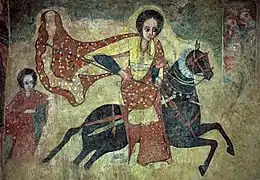
- Name: Makeda
- Source: Traditional Ethiopian lore surrounding Emperor Menelik I; see the Kebra Nagast
- Name: Nicaule
- Source: Josephus
- Name: Bilqis
- Source: Islamic traditions
Appears in the Bible at: 1 Kings 10; 2 Chronicles 9
According to Ethiopian traditions, the Queen of Sheba returned to Ethiopia pregnant with King Solomon's child. She bore Solomon a son that went on to found a dynasty that ruled Ethiopia until the fall of Emperor Haile Selassie in 1974.
Haman's mother
- Name: Amatlai bat Orevti
- Source: Babylonian Talmud, Bava Batra 91a [4]
Appears in the Bible at: Book of Esther
Old Testament deuterocanonicals

The Deuterocanonical books, sometimes called the "Apocrypha", are considered canonical by Catholics, Eastern Orthodox, and Oriental Orthodox (though these churches' lists of books differ slightly from each other).
Seven Maccabees and their mother
- Name: Habroun, Hebsoun, Bakhous, Adai, Tarsai, Maqbai and Yawnothon.
- Source: Maronite tradition
- Name: Abim, Antonius, Gurias, Eleazar, Eusebonus, Alimus and Marcellus.
- Source: Eastern Orthodox Tradition
The woman with seven sons is a Jewish martyr who is unnamed in 2 Maccabees 7, but is named Hannah, Miriam, Shamuna and Solomonia in other sources. According to Eastern Orthodox tradition, her sons, the "Holy Maccabean Martyrs" (not to be confused with the martyrs in the Ethiopian book of Meqabyan), are named Abim, Antonius, Gurias, Eleazar, Eusebonus, Alimus and Marcellus. According to the Syriac Maronite Fenqitho (book of festal offices), the name of the mother is Shmooni while her sons are Habroun, Hebsoun, Bakhous, Adai, Tarsai, Maqbai and Yawnothon.[24]
The seven Archangels
- Name: Michael, Gabriel, Raphael, Uriel, Selaphiel, Jegudiel and Barachiel
- Source: Byzantine Catholic and Eastern Orthodox Tradition
- Name: Michael, Gabriel, Raphael, Uriel, Camael, Jophiel, and Zadkiel.
- Source: Pseudo-Dionysius[25]
- Name: Michael, Gabriel, Raphael, Suriel, Zadkiel, Sarathiel, and Ananiel.
- Source: Coptic Orthodox tradition[26][27][28]
- Name: Michael, Gabriel, Raphael, Uriel, Sarakiel, Remiel and Raguel
- Source: Book of the Watchers
Tobit 12:15 reads "I am Raphael, one of the seven holy angels, which present the prayers of the saints, and which go in and out before the glory of the Holy One."[29] Of the six unnamed archangels, Michael is named in the Book of Daniel, and Gabriel is named in the Gospel of Luke.[30]
The Book of Enoch, deuterocanonical in the Ethiopian Orthodox Church, names the remaining four archangels Uriel, Raguel, Zerachiel, and Ramiel.[31] Other sources name them Uriel, Izidkiel, Haniel, and Kepharel.[32] In the Coptic Orthodox Church the names of these four archangels are given as Suriel, Sedakiel, Sarathiel and Ananiel. Several other sets of names have also been given.
New Testament
The Magi
.jpg.webp)
- Names: Balthasar, Melqon, Gaspar
- Source: Armenisches Kindheitsevangelium[33]
- Names: Balthasar, Melchior, and Caspar (or Gaspar)
- Source: European folklore
- Names: Basanater, Hor, and Karsudan
- Source: The Book of Adam, an apocryphal Ethiopian text
- Names: Larvandad, Hormisdas, and Gushnasaph
- Source: Syriac Christian folklore
- Names: Manatho, Alchor, and Gaspar
- Source: White Shrine of Jerusalem - Masonic
Appear in the Bible at Matthew 2.
The Gospel does not state that there were, in fact, three magi or when exactly they visited Jesus, only that multiple magi brought three gifts: gold, frankincense, and myrrh. Nevertheless, the number of magi is usually extrapolated from the number of gifts, and the three wise men are a staple of Christian nativity scenes. While the European names have enjoyed the most publicity, other faith traditions have different versions. According to the Armenisches Kindheitsevangelium, the three magi were brothers and kings, namely Balthasar, king of India; Melqon, king of Persia; and Gaspar, king of Arabia. The Chinese Christian Church believes that the astronomer Liu Xiang was one of the wise men.
The Nativity shepherds

- Names: Asher, Zebulun, Justus, Nicodemus, Joseph, Barshabba, and Jose
- Source: The Syrian Book of the Bee written by Bishop Shelemon in the Aramaic language in the thirteenth century.
Appear in the Bible at Luke 2.
Jesus' sisters
- Names: Maria
- Source: Gospel of Philip[34]
- Names: Assia and Lydia
- Names: Maria or Anna, Salomé
- Source: Epiphanius of Salamis[35]
- Names: Martha, Esther, and Salome
- Source: Hippolytus of Thebes, Chronicle[36]
That Jesus had sisters is mentioned in Mark 6:3 and Matthew 13:55–56, although their exact number is not specified in either gospel. See Brothers of Jesus § Jesus' brothers and sisters.
The various versions of Epiphanius differ on whether one of the sisters was named Maria or Anna.
The Innocents
- Names: Sicarius of Brantôme, St. Memorius
- Source: St. Helena[37][38][39][40]
Appears in the Bible at: Matthew 2:6–18.
Herodias' daughter
- Name: Salome
- Source: The Jewish Antiquities of Josephus,[41] although that reference does not connect her with John the Baptist.
Syrophoenician woman
- Name: Justa
- Source: 3rd century pseudo-Clementine homily[42]
Appears in the Bible at Matthew 15, Mark 7. According to the same source, her daughter was Berenice.
The child with Jesus
- Name: Ignatius
- Source: Early Christian Tradition
Appears in the Bible at Mark 9.
Several early Christian writers recorded a legend that the child whom Jesus took in his arms in Mark 9 was St. Ignatius of Antioch.[43]
Hæmorrhaging woman
- Name: Berenice
- Source: Apocryphal Gospel of Nicodemus
- Name: Veronica
- Source: Latin translation of the apocryphal Gospel of Nicodemus (Gos. Nicodemus 5:26)
Appears in the Bible at Matthew 9:20–22.
Veronica is a Latin variant of Berenice (Greek: Βερενίκη). Veronica or Berenice obtained some of Jesus' blood on a cloth at the Crucifixion (see also: Veil of Veronica). Tradition identifies her with the woman who was healed of a bleeding discharge in the Gospel.
Samaritan woman at the well
- Name: Photini
- Source: Eastern Orthodox Church Tradition
Appears in the Bible at John 4:5–42.
In the tradition of the Eastern Orthodox Church, the name of the woman at the well when she met Jesus is unknown, but she became a follower of Christ, received the name Photini in baptism, proclaimed the Gospel over a wide area, and was later martyred. She is recognized as a saint in the Eastern Orthodox Church.
Damned rich man
- Name: Nineveh
- Source: Coptic folklore
- Name: Phineas
- Source: Pseudo-Cyprian, De pascha computus
- Name: Dives
- Source: European Christian folklore
Appears in the Bible at Luke 16:19–31.
Dives is simply Latin for "rich", and as such may not count as a proper name. The story of the blessed Lazarus and the damned rich man is widely recognised under the title of Dives and Lazarus, which may have resulted in this word being taken for a proper name.
Woman taken in adultery
- Name: Mary Magdalene
- Source: Western Christian tradition
Appears in the Bible at John 8.
A long-standing Western Christian tradition first attested by Pope Gregory I identifies the woman taken in adultery with Mary Magdalene, and also with Mary of Bethany.[44] Jesus had exorcised seven demons out of Mary Magdalene (Mark 16:9), and Mary Magdalene appears prominently in the several accounts of Jesus' entombment and resurrection, but there is no indication in the Bible that clearly states that Mary Magdalene was the same person as the adulteress forgiven by Jesus. Roman Catholics also have identified Mary Magdalene as the weeping woman who was a sinner, and who anoints Jesus' feet in Luke 7:36–50, and while the Church has dropped this interpretation to a degree, this remains one of her more famous portrayals.
The Eastern Orthodox Church has never identified Mary Magdalene as either the woman taken in adultery, or the sinful woman who anointed Jesus' feet.
Pontius Pilate's wife
- Name: Claudia, Procla, Procula, Perpetua or Claudia Procles
- Source: European folklore; Dolorous Passion of our Lord Jesus Christ (as "Claudia Procles")[45]
Appears in the Bible at Matthew 27:19.
During the trial of Jesus the wife of Pontius Pilate sent a message to him saying, "Have nothing to do with that just man; for I have suffered many things this day in a dream because of him."
The proposed names of Procla and Procula may not be names at all, but simply a form of Pilate's official title of Procurator, indicating that she was the Procurator's wife.
Thieves crucified with Jesus
- Names: Titus and Dumachus
- Source: Acts of Pilate
- Names: Demas (the good thief)
- Name: Zoatham/Zoathan (the good thief)
- Source: Codex Colbertinus[47]
- Name: Rakh (the good thief)
- Source: Russian Orthodox tradition[48]
Appear in the Bible at: Matthew 27, Mark 15, Luke 23, John 19.
The good thief is revered under the name Saint Dismas in the Catholic Church and the Coptic Orthodox Church.
Soldier who pierced Jesus with a spear
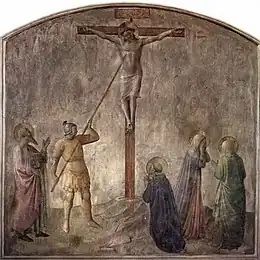
- Name: Longinus
- Source: Apocryphal Gospel of Nicodemus (Gos. Nicodemus 7:8)
Appears in the Bible at John 19:34.
In tradition, he is called Cassius before his conversion to Christianity.[49] The Lance of Longinus, also known as the Spear of Destiny, is supposedly preserved as a relic, and various miracles are said to be worked through it.
Man who offered Jesus vinegar
- Name: Agathon
- Source: Codex Egberti, 10th century
Appears in the Bible at Matthew 27:48, Mark 15:36, and John 19:29–30.
Guard(s) at Jesus' tomb
- Name of centurion: Petronius
- Source: Apocryphal Gospel of Peter (Gos. Peter 8)
- Names of soldiers: Issachar, Gad, Matthias, Barnabas, Simon
- Source: The Book of the Bee
Appears in the Bible at Matthew 27:62–66. Centurion possibly appears also in the Bible at Matthew 27:54.[50]
Ethiopian Eunuch baptized by the deacon Philip
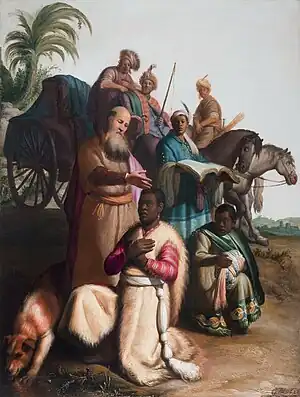
- Name: Simeon Bachos
- Source: Adversus haereses (Against the Heresies, an early anti-Gnostic theological work) 3:12:8 (180 AD)
- Name: Bachos
- Source: Ethiopian Orthodox Tewahedo tradition[51]
Appears in the Bible at Acts of the Apostles 8:27.
In Eastern Orthodox tradition[52] he is known as an Ethiopian Jew with the name Simeon also called the Black, the same name he is given in the Acts of the Apostles 13:1.
Daughters of Philip
- Name: Hermione; Eutychis; Irais and Chariline
- Source: Traditional. See Daughters of Philip
Appears in the Bible at Acts of the Apostles 21.8-9.
See also
References
- The Old Testament Pseudepigrapha: Expansions of the "Old ... James H. Charlesworth - 1985 "He seeks to destroy men's souls (Vita 17:1) by disguising himself as an angel of light (Vita 9:1, 3; 12:1; ApMos 17:1) to put into men "his evil poison, which is his covetousness" (epithymia, ..."
- Nod's Land Archived 26 February 2013 at archive.today. Avbtab.org.
- Medieval Sourcebook: The Golden Legend: Volume 1 (full text), Fordham.edu.(Dead link 2/2/2022)
- Bava Batra 91a, The William Davidson digital edition of the Koren Noé Talmud, Sefaria.org
- Book of Jasher, Chapter 19. Sacred-texts.com.
- Friedlander, Gerald, ed. (1916). Pirkê de Rabbi Eliezer. London: Paul, Trench, Trubner & Co. p. 186.
- Book of Jasher, Chapter 28. Sacred-texts.com.
- Book of Jasher, Chapter 34. Sacred-texts.com.
- Chapter VI: Jacob. Sacred-texts.com.
- Passage Lookup: 2 Timothy 3:8. BibleGateway.com.
- Book of Jasher, Chapter 79. Sacred-texts.com.
- "Antiquities of the Jews - Book II". Internet Sacred Text Archive. Retrieved 14 June 2018.
- Chapter 106. Sacred-texts.com.
- Ante-Nicene Fathers, Vol VIII: Apocrypha of the New Testament.: Chapter 5. Sacred-texts.com.
- Easton's Bible Dictionary. Sacred-texts.com.
- Chapter XXX – The History of Moses' Rod. Sacred-texts.com.
- Nicene and Post-Nicene Fathers, Vol. XIII: The Homilies of St. John Chrysostom on Timothy, Titus, and Philemon.: 2 Timothy 3:1–7. Sacred-texts.com.
- Chapter IV: Moses in Egypt. Sacred-texts.com.
- Job, Testament Of:. JewishEncyclopedia.com.
- Eric Geoffroy et Néfissa Geoffroy : Le grand livre des prénoms arabes – Plus de 5500 prénoms classés par thèmes avec leurs correspondances en français, Albin Michel, 2009.
- Adah Archived 29 November 2010 at the Wayback Machine, South Carolina Order of the Eastern Star website.
- Jewish Encyclopedia
- Rashi on 2 Samuel 20:19.
- Maronite Church, Fenqitho, v. 1, Lilyo of the Feast of Shmooni and Her Seven Sons
- A Dictionary of Angels, Including the Fallen Angels by Gustav Davidson, 1980, Free Press Publishing
- "2. Intercessors :: The Heavenly Orders Doxology :: ذوكصولوجية للسمائيين". tasbeha.org. Retrieved 18 March 2018.
- Alex, Michael Ghaly -. "رؤساء الملائكة الآخرين - كتاب الملائكة - St-Takla.org". st-takla.org. Retrieved 18 March 2018.
- Ghlay, Michael. "الملائكة.. ما هم، وما هو عدد وأسماء رؤساء الملائكه؟ - St-Takla.org". st-takla.org. Retrieved 18 March 2018.
- Tobit 12:15. Etext.virginia.edu.
- Daniel 12:1; Luke 1:19.
- Enoch XX. Sacred-texts.com.
- James Hastings, A Dictionary of the Bible: Volume IV, Part I: Pleroma–Shimon, 1898, reprinted 2004 by the Minerva Group, ISBN 1-4102-1728-0, p. 202 (RAPHAEL).
- Wilhelm Schneemelcher, Neutestamentarische Apokryphen. In deutscher Übersetzung: 2 Bde., Mohr Siebeck; 1999
- Wilhelm Schneemelcher, Neutestamentarische Apokryphen. In deutscher Übersetzung: 2 Bde., Mohr Siebeck; 1999, Vol. 1, p. 159
- Wilhelm Schneemelcher, Neutestamentarische Apokryphen. In deutscher Übersetzung: 2 Bde., Mohr Siebeck; 1999, Vol. 1, p. 363
- Curtin, D. P. (1 July 2023). Fragments of 'Chronicle'. ISBN 9781960069603.
- Wasyliw, Patricia Healy (2008). Martyrdom, Murder, and Magic: Child Saints and Their Cults in Medieval Europe. Vol. 2. Peter Lang. p. 46. ISBN 978-0-8204-2764-5.
- Craughwell, Thomas J. (2011). Saints Preserved: An Encyclopedia of Relics. Doubleday Religious Publishing Group. p. 267. ISBN 9780307590732.
- Jean Du Puy, L'Etat de l'Eglise du Périgord depuis le christianisme (Daloy, 1629), Original from Lyon Public Library (Bibliothèque jésuite des Fontaines). Digitized 20 December 2010, p. 268.
- "Abbatiale Saint-Pierre de Brantôme". PÉRIGORD Dronne Belle. Retrieved 9 March 2015.
- "Antiquities of the Jews – Book XVIII". Sacred-texts.com. Retrieved 12 August 2010.
- Orthodox Church Fathers, Pseudo-Clementine Literature, Chapter XIX.- Justa, a Proselyte, retrieved 31 December 2017
- O'Connor, J.B. (1910). "St. Ignatius of Antioch". Catholic Encyclopedia. New Advent.
- Italians find 'Jesus' foot salve', 10 December 2008
- Dolorous Passion Of Our Lord Jesus Christ. Jesus-passion.com.
- Ehrman, Bart; Plese, Zlatko (2011). The Apocryphal Gospels: Texts and Translations. New York: Oxford University Press. p. 582. ISBN 9780199732104.
a man named demas.
- Metzger, Bruce M.; Ehrman, Bart D. (2005). The Text of the New Testament: Its Transmission, Corruption, and Restoration (4th ed.). Oxford: Oxford University Press. p. 270. ISBN 978-019-516667-5.
- Renate Gerstenlauer, The Rakh Icon: Discovery of its True Identity, Legat Verlag, 2009 (ISBN 978-3932942358).
- "Longinus", in: Johann Evangelist Stadler et al., Vollständiges Heiligen-Lexikon, 1858–1882 (reprint: Hildesheim, 1996)
- A. T. Robertson (1982). Word Pictures in the New Testament - Matthew. CCEL. ISBN 9781610251884.
- Paulos, Abune (1988). The Mariological tradition of the Ethiopian Orthodox Tewahedo Church. New Jersey: Princeton University Press.
- History of the Church
Further reading
- "Names for the Nameless", in The Oxford Companion to the Bible, Bruce M. Metzger and Michael D. Coogan, editors. ISBN 0-19-504645-5
- Ilan, Tal. “Biblical Women’s Names in the Apocryphal Traditions.” Journal for the Study of the Pseudepigrapha 6, no. 11 (1993): 3–67.
- "The Poem of the Man God", Centro Editoriale Valtortiano srl, Maria Valtorta. (5 Volumes) no ISBN.
